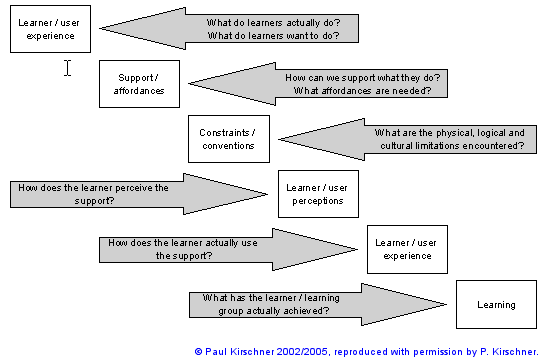Kirschner six-stage procedure
Definition
This instructional design method is described in Kirschner (2002) is particularly suitable for the development of computer-supported collaborative learning system. It is based on user-centered instructional design research.
The model
This is the original version (there are others in later publications) from Kirschner (2002:31-33):
1 Determine what learners actually do We as educators and instructional designers must abandon our own perspective and study the learner's perspective. We must watch students interact, observe collaborating groups interacting to solve problems, observe users interacting with software, et cetera, and do this before we begin to design and develop.
2 Determine what can be done to support those learners We must not be seduced from our own knowledge and ideas to determine what is technologically, educationally, or socially possible and then build, implement or stimulate it. Instead we must determine, based on stage 1, what actually needs to be supported / afforded and then proceed.
3 Determine the constraints of the learner, learning situation and learning environment and the conventions that already exist What physical, logical and cultural limitations will we encounter when trying to implement the support and what constraints will the learner encounter when trying to use that support? What conventions already exist and are we introducing new ones? Of paramount importance here is that we look further than the technological constraints and conventions and take into account the educational and social constraints and conventions that play a role in CSCL. The OUNL is an institution for higher education whose students are products of between 12 and 16 years of educational experience (indoctrination?), As such they are used to certain types of education and have been socialized to study, learn and act in specific ways. Denying or neglecting this will guarantee failure, both of our work and of their learning.
4 Determine how learners perceive and experience the support that we provide There is a world of difference between our (good) intentions and user perceptions thereof. We need to see and carry out research and design as iterative, interacting processes. We must verify our work by making ample use of prototypes, mock-ups and incremental design procedures. We must try these 'products' out with intended users at stages in their development where physical and conceptual changes can still be made. In this way we can assure not only the usefulness of the support (does it achieve what we want it to achieve?), but also the usability of that support (is it clearly defined such that its use is easily and correctly perceived by the learner?).
5 Determine how the learner actually uses the support provided Analogous to stage 1, and following up the more formative evaluations carried out in stage 4 we need to determine if the learner actually does what we hope / expect that (s)he will do.
6 Determine what has been learnt The goal of education is learning and there are three standards which can be used to determine the success of any instructional design, namely its effectiveness, its efficiency and the satisfaction of those learning (and also those teaching). An increase in one or more of these without a concomitant decrease in any of the others means success. This is the proof of the pudding.References
- Kirschner, P. A., Kreijns, K., Beers, P. J. & Strijbos, J-W. (2005). Designing electronic tools for collaborative learning environments. Educational Technology, 45(5), 48-52.
- Kirschner, P. (2002). Can we support CSCL? Educational, social and technological affordances for learning. In P. Kirschner (Ed.), Three worlds of CSCL: Can we support CSCL. Inaugural address, Open University of the Netherlands. PDF
